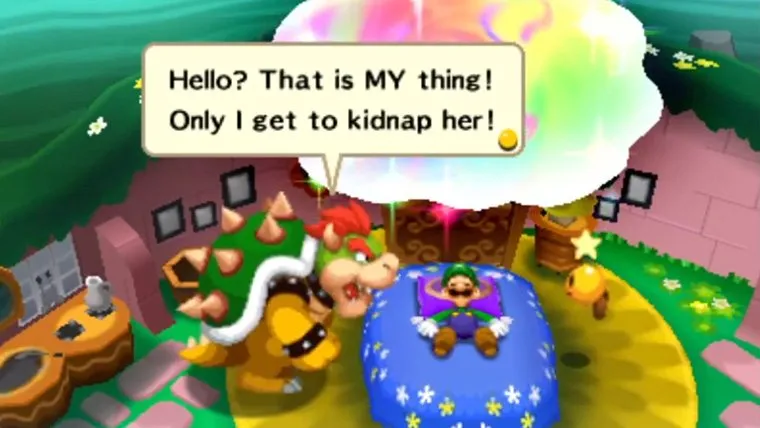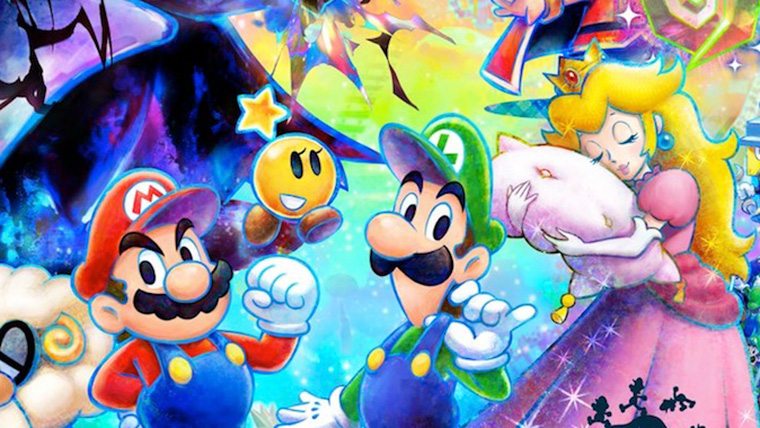The Mario Brothers have gone to some great lengths to rescue Princess Peach. Whether it’s through castle paintings, to faraway kingdoms or even outer space, Mario and Luigi will do whatever it takes to rescue their damsel in distress. However, in this new adventure, their quest will bring them to where the bros have never been before — inside Luigi’s dreams. But don’t expect Leonardo DiCaprio to show up, it’s once again all up to Mario to save the day.
Veterans of the Mario & Luigi franchise will feel right at home in Dream Team. The fourth installment in the series takes Nintendo’s iconic cast of characters: Mario, Luigi, Toadsworth and, of course, Princess Peach to a new, mysterious location — Pi’illo Island. Invited personally by Dr. Snoozemore, the island’s proprietor, the gang from the Mushroom Kingdom embarks on a much needed island vacation. However, Pi’illo Island isn’t everything it seems — it’s filled with many old secrets and hidden treasures throughout its diverse landscape. Although the beginning of Dream Team may seem slow, and almost boring, to those accustomed with the Mario & Luigi RPG series, the game does a great job reintroducing the familiar battle system as well as hitting hard and heavy on the story Pi’illo Island has to offer.
Formerly known as the Pi’illo Kingdom, Pi’illo Island is a tourist hub trying to make it big by inviting people from many lands and kingdoms. You’ll see some familiar faces around the island — not only from Mushroom Kingdom, but also from previous Mario & Luigi entries. While battling their way beneath the castle trying to — you guessed it — rescue Princess Peach, Mario and Luigi stumble upon the island’s long lost treasure: the pillow of the former kingdom’s prince. Believing it to be an ordinary pillow, Luigi decides to use the pillow after the exhausting battle to take a well-deserved nap.

But, of course, this is no ordinary pillow.
The island inhabitants claimed during the time of the Pi’illo Kingdom, some people could enter each other’s dreams. Luigi, being the heavy sleeper that he is, seems to bring this practice back to life as a large, colorful cloud appears above his head as he snoozes. As everyone stands in awe wondering what is happening, a large shadowy figure emerges and— you guessed it again — snatches Princess Peach, dragging her back through the cloud. Mario, without hesitation, jumps in after her.
Inside the Dream World seems like an acid trip for kids. Bright, colorful, ever-changing colors fill the screen along with multiple shapes and platforms for Mario to jump on. Gone is Pi’illo Island’s isometric 3D view. Everything in the Dream World is classic 2D platforming — a welcome change that helps keep the gameplay fresh. Also gone is the traditional Mario & Luigi battle system. While you continue running up to enemies to enter the battle sequence (jumping on their head still triggers a pre-emptive strike), Mario and Luigi no longer fight side by side. Instead, “Dreamy Luigi” becomes a part of Mario, helping him in battle with new and crazy fighting techniques — such as making multiple Luigis rain down on enemies after a jump attack. Also the Bros. Attack (a move which normally has Mario and Luigi team up for a devastating combo) has been replaced with the Luiginary Attack, which uses the multiple Luigis in fun and interesting ways.
Exploration in the Dream World is very different than Pi’illo Island. As you run around in the Dream World on the top screen, the bottom screen shows a sleeping Luigi. Using his “Luigination,” Luigi can bridge the Dream World and real world together through “Luiginary Works” — the developers love cramming Luigi’s name into as many things as possible, apparently. This technique allows Luigi to merge with items in the World — such as trees, tornados and clocks. Players tap, drag and rotate the stylus on the touchscreen to manipulate the world around Mario and help him advance. It can be a bit cumbersome trying to juggle using the stylus on the bottom screen and using the circle pad and buttons to help Mario move on the top screen at some later stages in the game, but the overall experience is a great way to break up the monotony of grinding through battles.
After exiting the Dream World for the first time, Mario learns the prince’s pillow Luigi was sleeping on was actually the Kingdom’s prince himself. Petrified by dark magic, the prince explains there are many other petrified Pi’illo people around the island and requests Mario’s help in rescuing them. As Mario enters the Dream World and rescues each Pi’illo person, he learns of Peach’s whereabouts as well as the dark force of the Pi’illo Kingdom’s past.
Without wanting to spoil any more of the story, players can expect what they always could from the Mario & Luigi series: a fun and interesting story with plenty of enjoyable, charming characters mixed with the characters you already know and love. The battle system is still as gratifying as before while using the experience points you earn to build up Mario and Luigi’s stats, as well as spending coins on items, gear and badges.
The main problem with Mario & Luigi: Dream Team is its difficulty — it’s a tad too easy. While it’s obvious the game was meant for kids with its simplistic puzzles, cheesy dialogue and lessons about teamwork, a few challenging puzzles or skillful battles would’ve been a welcome addition to those who started with the series a decade ago. Another example of the game’s ease appears when you fail a battle. Players are given the choice to “Try Again,” or “Try Again (Easy Mode)” — although the game already feels like it’s in easy mode. Choosing “Try Again” also gives players the opportunity to select a hint block during battle to learn the enemy’s vulnerabilities.
Another big weakness of the game comes in its early stages. Some of the most trivial game mechanics become over-explained in numerous tutorials at the beginning of the game. Explaining simple things such as how to jump and how to open the start menu can seem slightly insulting, even to newcomers. Furthermore, sometimes the game lacks focus. While it has many features to keep the gameplay dynamic, some of these moves or attacks quickly get swept under the rug, only to be forgotten as more and more things are introduced to the player — which lead to more and more unnecessary tutorials.
Finally, the game, at points, can also feel pretty long and repetitive. Dream Team is nearly twice the length of its predecessors clocking in between 35-40 hours of gameplay, and while some of the new mechanics are a novel addition, helping the hours fly by, other parts have me looking at the clock waiting to move on to the next area.
Despite these few weak points, the game is still a blast to play. As expected from Nintendo, the level of polish in this game is truly amazing. From the variety of colorful places to explore on Pi’illo Island, to the psychedelic adventures of the Dream World, Mario & Luigi: Dream Team visually looks fantastic. The fun and lively cast of characters mixed with terrific music (especially the boss music) throughout kept me wanting to go back and play a little more. While the game can seem kind of childish, the charming, cheesy humor that has been such a staple of the Mario & Luigi saga is amusing and entertaining. The game is easily accessible for both kids and adults — as well as newcomers to the series and veterans alike. If you’re a fan of the series, or simply a fan of RPGs in general, Mario & Luigi: Dream Team is highly recommended and a great addition to the ever-growing 3DS library.








Published: Aug 7, 2013 09:26 pm